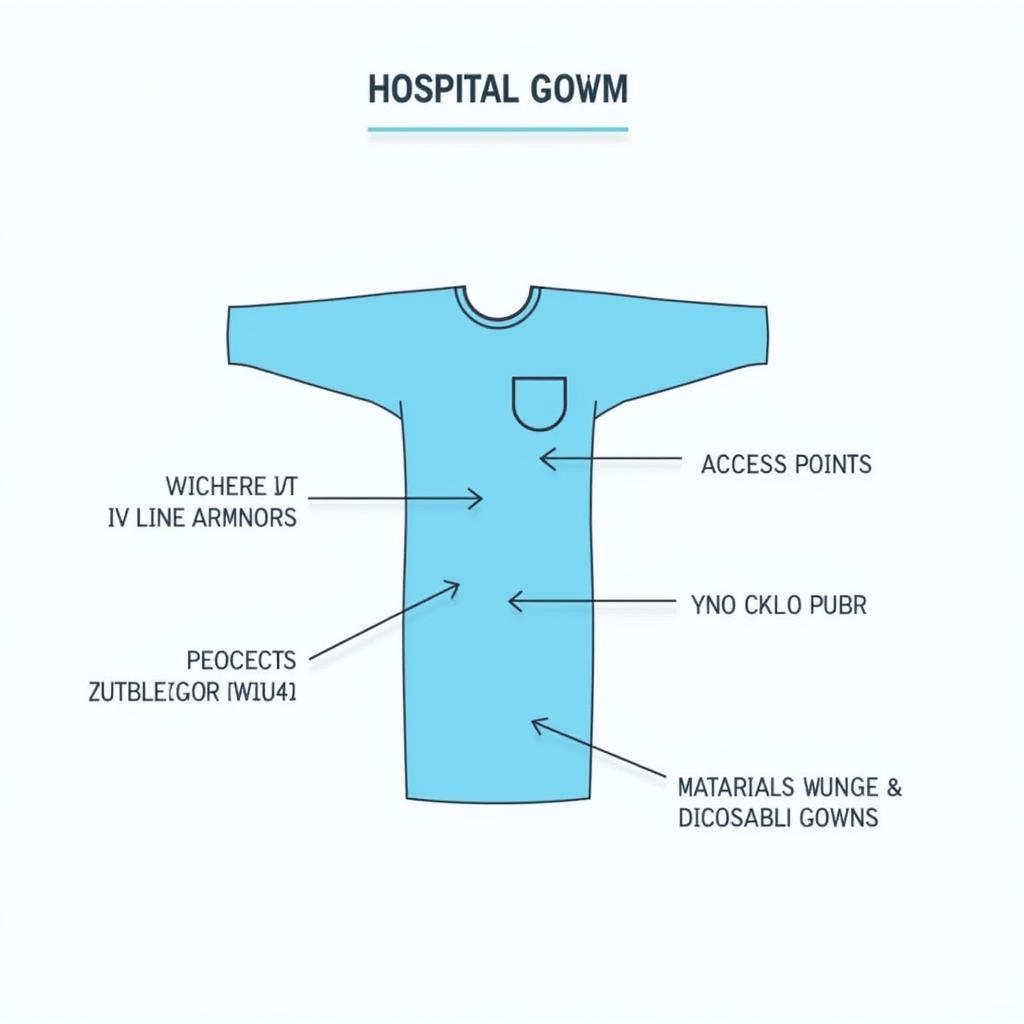Hospital Gown Costs are a frequent concern for patients, particularly those navigating the often-complex world of medical billing. While it might seem like a simple garment, several factors contribute to the final price you see on your bill. Let’s delve into what influences hospital gown costs and explore ways to navigate these expenses.
Material and Manufacturing: From Basic to Specialized
One of the primary factors affecting the cost of a hospital gown is the material used. Basic cotton gowns, while durable and reusable, require laundering, which adds to the overall expense. On the other hand, disposable gowns made from materials like polypropylene are designed for single use, eliminating laundry costs but contributing to waste.
Furthermore, specialized gowns designed for specific procedures, like those used in surgery or imaging, often incorporate additional features and materials, impacting their price. For instance, gowns used during X-rays might have lead-free shielding, while surgical gowns require higher levels of sterility, both contributing to increased manufacturing costs.
Location, Location, Location: Hospital Size and Geographic Variance
Believe it or not, the location and size of the hospital also play a role in determining hospital gown costs. Larger hospitals with higher patient volumes often benefit from economies of scale, potentially obtaining lower prices for bulk purchases. Conversely, smaller hospitals might face higher costs due to lower order volumes.
Additionally, geographic location can influence pricing due to factors like transportation expenses, regional differences in labor costs, and even local market demand for medical supplies.
Beyond the Basics: Added Features and Functionality
Hospital gowns are not created equal. Some gowns come equipped with features that, while enhancing patient comfort and functionality, can influence their overall cost. For instance:
- IV line access points: Gowns designed with strategically placed openings or snaps facilitate easier access for medical professionals administering intravenous medications or fluids.
- Pockets: While seemingly minor, adding pockets to gowns for patients to store personal items like glasses or dentures can increase manufacturing complexity and material requirements.
- Specialty closures: Gowns with alternative closures like snaps or ties, especially those designed for specific medical conditions or needs, might contribute to a slightly higher cost compared to standard tie-back gowns.
 Hospital Gown Features that Impact Cost
Hospital Gown Features that Impact Cost
Navigating Hospital Gown Costs: Tips for Patients
While the cost of a hospital gown is a necessary part of medical care, understanding the factors influencing the price can help manage expectations. Here are a few tips to keep in mind:
- Inquire about gown policies: Don’t hesitate to ask your healthcare provider or the hospital about their gown policies. Some facilities might offer reusable gowns for certain situations, potentially reducing costs.
- Explore alternatives: If appropriate for your medical needs and with the guidance of your doctor, consider options like comfortable clothing from home that allows for necessary medical access.
- Factor gown costs into budgeting: When anticipating medical expenses, remember to include the potential cost of hospital gowns.
- Review your bill carefully: After your hospital stay, carefully examine your bill for any discrepancies or unclear charges related to hospital gowns.
- Communicate with billing departments: If you have questions or concerns about gown costs on your bill, reach out to the hospital’s billing department for clarification.
Hospital Gowns: A Small Part of a Larger Picture
While the cost of a hospital gown might seem insignificant compared to other medical expenses, it’s essential to remember that transparency and understanding contribute to a positive patient experience. By comprehending the factors that influence pricing, patients can engage in more informed conversations with their healthcare providers and navigate the financial aspects of their care with greater confidence.
Remember, communication is key. Don’t hesitate to ask questions and advocate for clarity regarding any aspect of your medical billing, including the cost of hospital gowns.
FAQ: Addressing Common Questions About Hospital Gown Costs
1. Are hospital gown costs typically included in the overall hospital bill?
Yes, in most cases, the cost of hospital gowns is factored into the overall hospital bill. However, the specific way it appears on the bill might vary depending on the hospital’s billing practices.
2. Can I refuse to wear a hospital gown if I’m concerned about the cost?
While you have the right to decline a hospital gown, it’s crucial to consult with your doctor. They can advise on whether wearing one is medically necessary for your situation and suggest alternatives if appropriate.
3. Do hospitals offer financial assistance programs that cover hospital gown costs?
Some hospitals might have financial assistance programs that encompass various medical expenses, potentially including gown costs. Inquire with the hospital’s financial counseling department to explore available options.
4. Are there situations where I might receive a separate charge for a hospital gown?
In certain scenarios, like specialized procedures requiring specific gowns with added features, a separate charge might apply. Your healthcare provider or the hospital’s billing department can provide clarity on such instances.
5. If I need multiple gowns during my hospital stay, will I be charged for each one?
Billing practices vary, but typically, the cost of multiple gowns used during a single hospital stay is incorporated into the overall bill rather than itemized per gown.
Exploring Further: Additional Resources
- mri at hospital vs imaging center: Learn about the cost differences between getting an MRI at a hospital versus an imaging center.
- hoag hospital mri: Find information about Hoag Hospital’s MRI services.
Need Assistance? Contact Us
For any questions or concerns, please don’t hesitate to contact our dedicated team:
Phone: 02437655121
Email: [email protected]
Address: Số 298 Đ. Cầu Diễn, Minh Khai, Bắc Từ Liêm, Hà Nội, Việt Nam.
We’re available 24/7 to provide support and guidance.